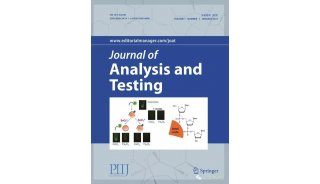Preparation of Bacterial Proteins for Analysis by 2D-PAGE
The following protocol has been developed for preparing soluble bacterial proteins in a form suitable for analysis by 2D-PAGE. The procedure was principally developed for the analysis of proteins extracted from Gram negative bacteria grown on solid agar media. A number of modifications to the basic protocol are listed for other bacterial groups and alternative growth conditions.
Stock solutions
In addition, to the basic growth media that are specific to the bacteria under study the following buffers are used.
2D Lysis Buffer
0.01M Tris-HCl, pH7.4
1mM EDTA
8M Urea
0.05M DTT
10% (v/v) glycerol
5%(v/v) NP40
6% (w/v) ampholytes
The buffer is made up using high purity MilliQ water
NOTES:
Use Aristar grade Urea from Merck-BDH - or a similar high purity urea.
The ampholyte solution currently used is "Resolyte" pH 3.5-10 from Merck-BDH. The buffer requires an alkaline ampholyte solution, which reduces protease activity as well as precipitating DNA in the sample. Commercially produced ampholyte stock solutions are at a concentration of 40% (w/v).
A protease inhibitor can be added to the lysis buffer. PMSF at 1-2 mM can be used, but the compound is not stable for long-term storage. There are also a number of other protease inhibitor cocktails available commercially.
Nucleases (e.g. DNAse and RNAse A) can be added at ca. 0.2 mg/ml to help remove nucleic acid contaminants.
CHAPS can replace the NP40 at a concentration of 2-4% (w/v).
Once prepared, the 2D Lysis Buffer is divided into smaller volumes (e.g. 1-1.5 ml) and stored frozen in sterile microfuge tubes at -70oC until required. A tube of lysis buffer is thawed as required and any remaining lysis buffer is discarded - avoid re-freezing the 2D Lysis Buffer.
PBS-A
171mM NaCl
3.3mM KCl
10mM Na2PO4
2mM NaH2PO4
Method
The following procedure is based on bacteria grown on solid agar media under the conditions required for the bacteria under study. The number of plates required will depend on how well the bacteria have grown. In many cases, a single plate incubated overnight provides sufficient material for analysis. For poor growing bacteria the material from a number of plates incubated for 24-48 hours can be pooled together. It is essential to avoid making the protein solution too dilute at this stage, since this can cause problems for protein detection following gel electrophoresis.
Examples of recovery for specific bacteria are provided below:
Haemophilus influenzae, Neisseria meningitidis: Lyse an overnight plate culture in 0.5 ml 2D Lysis Buffer.
E. coli: For well-growing isolates a half (or third) plate after overnight incubation can be lysed in 0.5 ml 2D Lysis Buffer.
Streptococcus pneumoniae: Lyse 3 plates of bacteria (24-48 hour growth) in 0.5 ml 2D Lysis Buffer.
These should be used as a guide and modified as appropriate for the organisms under study.
Basic Lysis Procedure
Scrape the bacteria from the surface of the agar using either a sterile swab or plastic disposable plating loop. Although the swab allows direct resuspension into the 2D Lysis Buffer, there may be some sample loss. In contrast, the loop method can lead to clumping of the bacteria and it is generally preferable to resuspend the bacteria in a wash buffer (see below) rather than into the lysis buffer immediately.
Dislodge the bacteria from the swab or loop directly into 0.5ml 2D Lysis Buffer (held in 1.5ml microfuge tube) and resuspend the bacteria.
Leave on ice for ca. 5 minutes.
Remove insoluble cell debris by centrifugation on a microfuge at 11,000g for 5minutes.
Store the supernatant, containing the soluble bacterial proteins, at -70C until required.
Suggested Modifications
The following are suggested modifications to the basic procedure that can be applied depending on the particular organism being analysed.
The removal of the bacteria from the surface of the agar plate can be aided by flooding the plate with a low salt buffer (e.g. PBS-A or 0.01M Tris-HCl, pH7.4 or distilled water [MilliQ quality]). Be careful to avoid lumps of agar from contaminating the samples.
Following removal of the bacteria from the plate the bacteria, instead of resuspending the bacteria directly in 2D Lysis Buffer they can be resuspended in 1 ml of low salt buffer (e.g. PBS-A or 0.01M Tris-HCl, pH7.4 or distilled water [MilliQ quality]) as a wash step prior to lysis. All of the wash buffer must be removed from the cell pellet before lysing the cells. The wash step should be included as routine if a plating loop is used to remove the bacteria from the culture plate. For centrifugation of the samples during the washes a low speed (e.g. 5000g for 5minutes) will prevent the bacterial pellet from being too hard and difficult to suspend.
For bacteria grown in liquid broth, the bacteria should be washed (at least twice in 1ml each wash) in a low salt buffer (e.g. PBS-A or 0.01M Tris-HCl, pH7.4 or distilled water [MilliQ quality]) prior to lysis. Once the cells have been concentrated (ca. 1000g for 5minutes) from the large volume of growth medium the subsequent washes are carried out in microfuge tubes. Avoid pelleting the bacteria too hard during the wash steps, as the cells can be hard to resuspend for complete lysis. All of the wash buffer must be removed from the cell pellet before lysing the cells.
The volume of 2D Lysis Buffer used to lyse bacteria grown in broth culture will depend on the efficiency of growth - for example H. influenzae recovered from 25-30 ml of broth culture (culture OD of approximately 0.7-0.8) can be lysed in 0.5 ml 2D Lysis Buffer.
Sonication of bacterial suspension
For Gram-positive bacteria, as well as Gram-negative bacteria with capsules, a sonication step (use a sonicating probe rather than a sonication bath) can be included once the bacteria are in the 2D Lysis Buffer. The length of the sonication is empirically determined, but the following can serve as a guide:
E. coli - capsulate strains: 3 x 20 seconds
S. pneumoniae - Gram positive bacterium: 6 x 30 seconds
During the sonication the protein suspension is kept cold - ideally held on ice during each period of sonication. For prolonged sonication use short bursts (e.g. 30 seconds) allowing the protein/bacterial suspension to cool on ice between each burst.
It may be necessary to increase the volume of lysis buffer slightly in order to ensure that the probe is completely immersed in the protein solution. Any increase should be kept to a minimum to avoid diluting the proteins.
Following lysis, the soluble protein suspension can be freeze-dried in the microfuge tube and sent for analysis by post; the sample is resuspended in the same volume of MilliQ water as used for the 2D Lysis Buffer.
Estimating gel loading
Loading of the 2D gels is determined empirically by analysing the protein samples by 1D-PAGE. If it is necessary to determine the actual protein concentration this must be done before mixing the bacteria with the 2D Lysis Buffer, since the latter can interfere with standard protein assays.
One approach to standardise the loading of the gels is to take an OD reading (605nm is used for H. influenzae and S. pneumoniae) using the following protocol.
Scrape the bacteria from the agar plate and suspend in PBS-A. For bacteria grown in broth culture include an additional wash step at this point to remove any coloured products present in the culture media.
Pellet the cells and suspend in PBS-A - use a standard volume e.g. 1ml. Sample this suspension and dilute as required. A 1:50 dilution can normally be used for this step. Now take the OD (605nm) of this suspension.
The bacteria in the original suspension are collected by centrifugation and resuspended in the appropriate amount of 2D lysis buffer based on the OD reading of the diluted bacterial suspension in the previous step. For example, with S. pneumoniae the pellet is resuspended in 0.1ml of 2D lysis buffer for each 0.1 OD reading obtained. This needs to be determined empirically for each bacterium under study.
-
焦点事件

-
焦点事件










